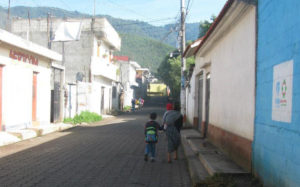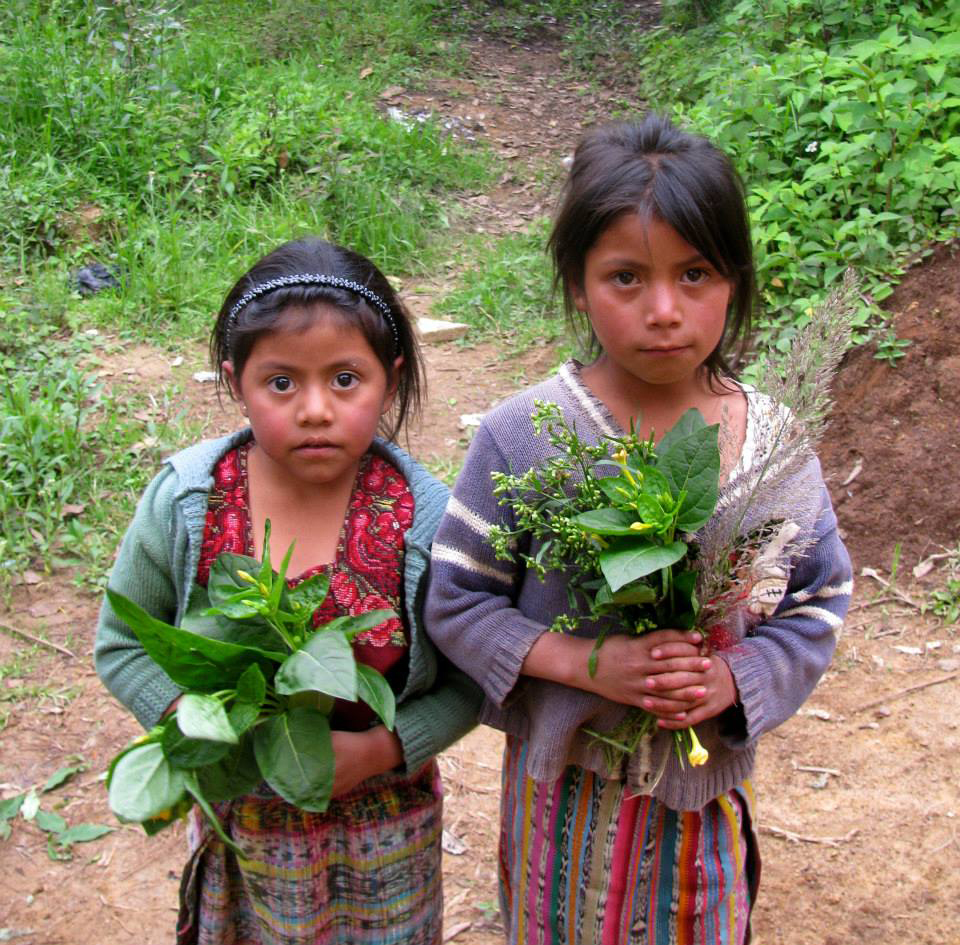Photo by: Meghan Farley Webb.
Perspectives in Infant Mental Health are delighted to share this new paper with you: Language Interpretation in the Administration of the Bayley Scales of Infant Development-III for an Indigenous Population in Guatemala. It has been written by colleagues in Guatemala and USA: Meghan Farley Webb (Guatemala and USA), Boris Martinez (Guatemala and USA), Patricia Rodas (Guatemala), Ana Gonzalez (Guatemala), Peter Rohloff (Guatemala and USA), and Maria del Pilar Grazioso (Guatemala).
This paper addresses cultural and linguistic issues associated with the adaptation of western assessment tools. The authors, Farley Webb et el., state that: “Such adaptations are especially difficult when working in indigenous or minority languages that may not have a standardized written form”. The paper especially addresses the interpretation processes specific to the administration of the Bayley Scales of Infant Development-III (BSID-III) in Kaqchikel Maya, an indigenous language of rural Guatemala. A case study is provided that illustrates the interpretation and translation process that was used to adapt the Bayley Scales of Infant Development-III (BSID-III) for use in this indigenous community. While being specific to this rural community, the paper also contributes to our appreciation of, understanding, and discussions regarding the interpretation of psychometric tests in indigenous languages with families and their babies.

Language Interpretation in the Administration of the Bayley Scales of Infant Development-III for an Indigenous Population in Guatemala
Abstract
Careful cultural and linguistic adaptation of Western assessment tools can produce meaningful clinical or social information about early child development in non-Western populations. Such adaptations are especially difficult when working in indigenous or minority languages that may not have a standardized written form. In such situations, linguistic interpretation is necessary; however, details regarding interpretation procedures are rarely documented in published manuscripts. This article describes the training procedures, common difficulties encountered, and assumed roles of linguistic interpreters in the administration of the Bayley Scales of Infant Development-III (BSID-III) in Kaqchikel Maya, an indigenous language of rural Guatemala. This case study demonstrates that the use of psychometric tools in indigenous or minority linguistic communities requires the active participation of skilled interpreters, who serve as “co-testers,” actively participating in the evaluation process, maintaining caregiver and child engagement through iteration and improvisation “on-the-fly,” and mediating a respectful and productive intercultural dialogue between the testing team and participants. We found that hiring and training female native speakers, rather than professional interpreters, allowed us to improve rapport between non-indigenous psychologists and Maya caregivers. Ongoing discussion and training improved the comprehensibility of BSID-III test items. By describing our experiences interpreting the BSID-III into Kaqchikel Maya, this article aims to contribute to the larger discussion of interpretation procedures used to adapt psychometric tests into other indigenous or minority languages.
Keywords: early child development, methodology, minority languages, Maya, Guatemala
Introduction
Previous scholarship has demonstrated that with careful cultural and linguistic adaptation Western assessment tools can produce meaningful clinical or social information about early child development (ECD) in non-Western populations (Biasini et al., 2015; Bornman, Sevcik, Romski, & Pae, 2010; Heo, Squires, & Yovanoff, 2008; Kvestad et al., 2013; Lara Díaz, Gálvez Bohórquez, Gómez Fonseca, Guechá, & Sellabona, 2011; Steenis, Verhoeven, Hessen, & van Baar, 2014). Although many published studies carefully document the procedures used to validate or adapt assessment tools to different cultures (Biasini et al., 2015; Bornman et al., 2010; Clinton, Edstrom, Mildon, & L., 2015; Heo et al., 2008; Kvestad et al., 2013; Lara Díaz et al., 2011; Steenis et al., 2014), the issue of language interpretation is less well represented in the literature. This issue is especially important when working translinguistically or when a language does not have a commonly accepted written form, as is often the case with minority or indigenous languages. Language interpretation is not a straightforward skill, and procedures used to train or incorporate interpreters into the assessment team are rarely detailed in published manuscripts (Wallin & Ahlström, 2006). This article aims to contribute to this discussion by describing the interpretation procedures used during the administration of the Bayley Scales of Infant and Toddler Development (BSID)-III (Bayley, 2006) among a group of Kaqchikel Maya (henceforth Kaqchikel) mother-child dyads in rural Guatemala.
Context
Guatemala is a Central American country of roughly 16 million; nearly half of the population self-identifies as indigenous, speaking one of 22 Mayan languages. Despite their majority, contemporary Maya have been marginalized from the dominant society, and suffer from marked socioeconomic and health disparities (Ministerio de Salud Pública y Asistencia Social, Instituto Nacional de Estadística, & Secretaría de Planificación y Programación de la Presidencia, 2015). Reflecting this dichotomy, Guatemala has the highest prevalence of stunting (low height-for-age) in Latin America, with indigenous children disproportionately affected. In rural Maya communities, stunting rates often exceed 75 percent for children under 5 years of age (Black et al., 2013). Unsurprisingly, in these indigenous communities most children are at risk for delayed ECD (Chary et al., 2013). However, the extent of delay in various domains remains unknown, in large part because linguistic barriers (especially Maya language monolingualism of mothers) impede the adaptation and administration of existing ECD tools. We recently completed a randomized clinical trial to explore the effects of malnutrition on ECD (NCT02509936) in a rural Kaqchikel population. As part of that study, we adapted the BSID-III to Guatemalan Spanish (the language of our clinical team). However, the target language for administration for the trial was Kaqchikel. While Kaqchikel has had a standard written form for several decades, exceedingly few individuals (including Kaqchikel professionals) are literate in Kaqchikel (England, 2003). It was, therefore, impractical to develop a standardized Kaqchikel written BSID-III, and we explored the feasibility of BSID-III administration with concurrent interpretation from Spanish to Kaqchikel by bilingual interpreters. This paper documents the training procedures, common difficulties encountered, and assumed roles of our interpreters.
Methods
Participants
Three hundred twenty-four mother-child dyads participated in the administration of the BSID-III in Kaqchikel as part of a clinical trial (NCT0209936). These dyads were recruited for participation from rural hamlets surrounding the city of Tecpán, Guatemala. Child subjects were recruited based on prespecified inclusion criteria, which included: (1) age 6-24 months, (2) height for age Z-score of ≤ 2.5, and (3) no obvious congenital abnormalities or severe medical illness. The age range of mothers was 16-49 years, with an average age of 27.06 ± 6.80 years. On average, mothers had completed 2.29 ± 2.46 years of primary school and their preferred language was Kaqchikel.
The interdisciplinary research team contained both indigenous and non-indigenous staff and included physicians, nurses, anthropologists, psychologists, and interpreters. Importantly, none of the psychologists administering the BSID-III were indigenous or spoke Kaqchikel, making the seven native Kaqchikel-speaking interpreters critical to the team. All interpreters were female, with an age range of 22-27 years. While none of the translators were professional interpreters, all were native speakers of both Spanish and Kaqchikel and were trained to use vernacular language in study encounters.
Procedure
Despite official recognition of Mayan languages (England, 2003), there are no accreditation or training programs for Mayan language translators. Maya linguists often fill the role of “professional” interpreters, without undergoing a training or certification process. Indeed, Maya linguists frequently use standard grammatical structure that varies greatly from vernacular Kaqchikel and employ neologisms which are incomprehensible to typical speakers (Tummons, Henderson, & Rohloff, 2008). Therefore, we hired native Kaqchikel speakers with experience as elementary school teachers rather than linguists. This decision promoted communication and rapport, rather than the use of a formal grammatical register unfamiliar to rural speakers.
Interpreters participated in twenty hours of intensive orientation by the interdisciplinary team that included review of the ancillary materials to be used in the testing (such as stimulus materials and Likert scales) and detailed discussion of each test item, including a discussion of the theory behind and purpose of each item. Training also included guidance on data collection procedures, especially accurate recording of responses, and navigating cultural missteps. Finally, interpreters’ training included active participation in the full administration of the BSID-III to both team members and a group of volunteer Kaqchikel mothers. These interactions allowed interpreters to receive feedback on their interpretation and data collection techniques and to practice linguistic and cultural interpretation and the management of interpersonal dynamics between non-indigenous psychologists and indigenous caregivers. This practice was critical to strengthening the necessary collaboration between interpreters and evaluators.
Completion of training did not mark the end of the process of interpretation. Throughout the study period, interpreters regularly discussed problematic phrasings with the larger research team who supervised any changes in phrasing. At the mid-point of the study, study coordinators held a focus group with the interpreters to further discuss the interpreters’ general impressions and specific concerns of both the questions and interaction portions of the BSID-III. Insights from these interactions form the bulk of the findings reported below.
Results
Early feedback from interpreters centered around the linguistic and cultural impasses they had to navigate during test administration. Unsurprisingly, interpreters reported linguistic difficulties related to word choice. For example, in initial rounds of phrasing testing, the Kaqchikel-speaking members of the research team decided that “samaj” (work; job) was the best translation of “activity.” However, focus group discussion with interprets revealed that mothers had difficulty applying this word to children. They perceived “samaj” as referring to the duties of adults rather than age-appropriate activities of children. Providing mothers with examples of children’s activities clarified our use of “samaj” and improved comprehensibility.
In a similar vein, negative and two-part questions were problematic. Interpreters described caregivers signaling responses incongruent with previous responses or behaviors they witnessed children achieving. Two-part questions were particularly problematic, with most mothers responding to the first half, rather than the whole question, according to interpreters. Interpreters also described mothers’ frustration with what they perceived as repeat questions. For example, mothers did not differentiate between children’s use of gestures, sounds, and words making items querying children’s communication abilities problematic. To ensure comprehension interpreters signaled two-part questions asking mothers to respond to the whole question, not just the first part. Similarly, interpreters pointed out the differences in perceived “repeated” questions.
In addition to these linguistic interactions, interpreters also had to navigate cultural disparities. Interpreters described how BSID-III items querying the type of play between caregiver and children highlighted the fact that the overwhelming majority of mothers did not have time for dedicated “play” with their child. Mothers described days filled with domestic tasks, and, therefore, had a difficult time responding to these items. Similarly, mothers signaled that their children did not like “a variety of foods.” However, interpreters felt that these negative responses were demonstrative of endemic poverty and food insecurity rather than any substantial difference in the child’s developmental achievements. Questions about dedicated “play” were altered to reflect any caregivers’ (especially older siblings’) play with children. Interpreters tried providing examples for items querying various foods, but these questions still proved difficult to interpret.
Perhaps the greatest cultural obstacle interpreters had to mediate in the interpretation of the BSID-III was Guatemala’s s ongoing legacy of ethnic discrimination against Maya populations. For example, the non-indigenous evaluators cleaned toys after completing interactions, as is normal practice. However, indigenous mothers reacted negatively, perceiving this practice as emblematic of non-indigenous’ perception of indigenous peoples as “dirty.” Interpreters described having to reassure caregivers that toy cleaning was done with all children regardless of ethnic background and was not because evaluators thought indigenous children were dirty.
Discussion
As focus group discussions and debriefing interactions with interpreters revealed, transcultural and translinguistic interpretation of the BSID-III is not straightforward; it requires navigation of both linguistic and cultural obstacles. Since the role of the interpreter in testing environments is often insufficiently described (Wallin & Ahlström, 2006), this article aims to call to attention the degree to which the interpreter is as an integral member of the testing team. We believe that more detail to the processes of training and integrating interpreters into testing teams is critical when describing such efforts in indigenous or linguistic minority communities worldwide.
We strategically hired non-professional interpreters with experience interacting with women and young children in order to create a framework focused on building rapport and creating a therapeutic alliance. We specifically avoided using “professional” Kaqchikel interpreters, given that they are few in number, typically inexperienced with early child interactions and almost exclusively all trained as linguists or language revitalization specialists and therefore use many neologisms and a high grammatical register that we feared would alienate to our rural cohort (England, 2003). We also chose to employ only female interpreters, given local gender norms that consider childcare “women’s work.” Furthermore, we felt female interpreters could more easily establish rapport with mothers. These choices, combined with training that explicitly discussed the ways interpreters would have to facilitate and mediate cross-cultural understandings between the research team and caregivers, allowing for successful administration of the BSID-III.
As our experience highlights, the role of interpreters in early child testing environment extends beyond simple linguistic interpretation. Interpreters facilitate and mediate intercultural interactions between evaluators, caregivers, and children. This allows caregivers from distinct cultural backgrounds or with limited experience with formal testing environments to participate in the evaluation of their children in meaningful ways, ensuring more accurate evaluation (Klein, 2000; Mares & Graeff-Martins, 2012; Thurman, 2015). When caregivers and evaluators do not speak the same language, the therapeutic alliance is immediately ruptured; it is only through interpretation that rapport can be established. In such cases, interpreters become an integral part of the testing team, leaving aside any supposed neutral technical role to bridge the cultural divide between tester and subject.
As this case study from indigenous rural Guatemala demonstrates that the use of psychometric tools in indigenous or minority linguistic communities goes beyond just simple translation and adaptation. It requires the active participation of skilled interpreters, who serve as “co-testers,” actively participating in the evaluation process, maintaining caregiver and child engagement through iteration and improvisation “on-the-fly,” and mediating a respectful and productive intercultural dialogue between the testing team and participants.
Acknowledgments
We thank the subjects, their families, and communities for their participation in this study. We thank Georgina Lopez, Magali Batz, Rosa Tecun, Yolanda Riquiac, Yolanda Juarez, Nely Saquec, and Lesly Coy for their work on the study. We thank Daniel Tse, Katia Levine, and Chase Adam at Watsi, and Katia Cnop and Jessica Hawkins at Wuqu’ Kawoq for their assistance with treatment funding. Study funding: Saving Brains Grand Challenges Canada, Grant # 0720-03, to PR.
References Cited
Bayley, N. (2006). Bayley Scales of Infant Development. Third Edition: Pearson Education, Inc.
Biasini, F. J., De Jong, D., Ryan, S., Thorsten, V., Bann, C., Bellad, R., McClure, E. (2015). Development of a 12 Month Screener Based on Items from the Bayley II Scales of Infant Development for use in Low Middle Income Countries. Early Human Development, 91(4), 253-258.
Black, R. E., Victora, C. G., Walker, S. P., Bhutta, Z. A., Christian, P., de Onis, M., Ezzati, M., et al. (2013). Maternal and Child Undernutrition and Overweight in Low-Income and Middle-Income Countries. Lancet, 382(9890), 427-451.
Bornman, J., Sevcik, R. A., Romski, M. A., & Pae, H. K. (2010). Successfully Translating Language and Culture When Adapting Assessment Measures. Journal of Policy and Practice in Intellectual Disabilities, 72(2), 111-118.
Chary, A., Messmer, S., Sorenson, E., Henretty, N., Dasgupta, S., & Rohloff, P. (2013). The Normalization of Childhood Disease: An Ethnographic Study of Child Malnutrition in Rural Guatemala. Human Organization, 72(2), 87-97.
Clinton, A., Edstrom, L., Mildon, H., & L., D. (2015). Social emotional learning in a Guatemalan preschool sample: Does socioeconomic status moderate the effects of a school-based prevention program?. School Psychology International, 36(1), 18-35.
England, N. C. (2003). Mayan Language Revival and Revitalization Politics: Linguistics and Linguistic Ideologies. American Anthropologist, 105(4), 733-743.
Heo, K. H., Squires, J., & Yovanoff, P. (2008). Cross-Cultural Adaptation of a Pre-School Screening Instrument: Comparision of Korean and U.S. Population. Journal of Intellectual Disability Research, 52(3), 195-206.
Klein, P. (2000). Handbook of Psychological Testing (2nd ed.). New York: Routledge.
Kvestad, I., Taneja, S., Kumar, T., Bhadari, N., Strand, T. A., & Hysing, M. (2013). The Assessment of Developmental Status Using the Ages and Stages Questionnaire-3 in Nutritional Research in North Indian Young Children. Nutrition Journal, 12(50), 1-11.
Lara Díaz, M. F., Gálvez Bohórquez, D. M., Gómez Fonseca, Á. M., Guechá, C. M., & Sellabona, E. S. (2011). Normativización del Invenario de Desarollo Comunicativo MacArthur-Bates al español, Colombia [Normalization to the Spanish-Colombia to the CDI-MacArthur-Bates Communicative Development Inventories]. Revista Latinoamericana de Psicología, 43(2), 241-254.
Mares, S. P., & Graeff-Martins, A. S. (2012). The Clinical Assessment of Infants, Preschoolers, and Their Families. In J. M. Rey (Ed.), IACAPAP Textboook of Child and Adolescent Mental Health (pp. 1-22). Geneva: International Associoation for Child and Adolescent Psychiarty and Allied Professions.
Ministerio de Salud Pública y Asistencia Social, Instituto Nacional de Estadística, & Secretaría de Planificación y Programación de la Presidencia. (2015). Encuesta Nacional de Salud Materno Infantil 2014-2015: Innforme de Indicadores Básicos. Retrieved from Guatemala City.
Steenis, L. J. P., Verhoeven, M., Hessen, D. J., & van Baar, A. L. (2014). First Steps in Developing the Dutch Version of the Bayley III: Is the Original Bayley and Its Item Sequence Also Adequate for Dutch Children. European Journal of Developmental Psychology, 11(4), 494-511.
Thurman, S. L. (2015). Ethical Considerations in Longitudinal Studies of Human Infants. Infant Behavioral Development, 38, 116-125.
Tummons, E., Henderson, R., & Rohloff, P. (2008). So that we don’t lose words: Reconstructing a Kaqchikel medical lexicon. Paper presented at the First Biennial Symposium on Teaching Indigenous Languages in Latin America, Bloomington, IN.
Wallin, A.-M., & Ahlström, G. (2006). Cross-cultural Interview Studies Using Interpreters: Systematic Literature Review. Journal of Advanced Nursing, 55(6), 723-735.
Authors
Webb, Meghan Farley 1, 2
Martinez, Boris 1, 3
Rodas, Patricia 4
Gonzalez, Ana 1
Rohloff, Peter 1, 5
del Pilar Grazioso, María 6
1 Wuqu’ Kawoq|Maya Health Alliance, Santiago Sacatepéquez, Guatemala
2 Albion College, Albion, MI, USA
3 Department of Medicine, Saint Peter’s University Hospital, New Brunswick, NJ, USA
4 Universidad del Valle, Guatemala City, Guatemala
5 Division of Global Health Equities, Brigham and Women’s Hospital, Boston, MA, USA
6 Proyecto Agilé Guatemala, Guatemala City, Guatemala
Corresponding Author: María del Pilar Grazioso, mpgrazioso@proyectoaigle.org.gt








